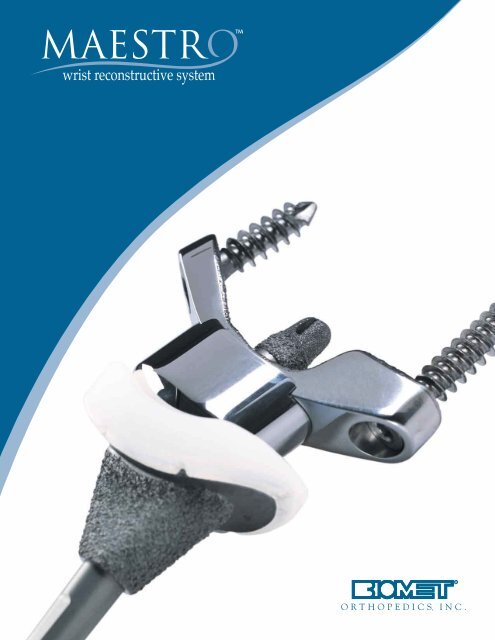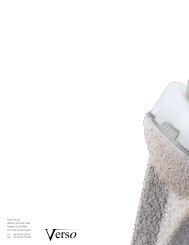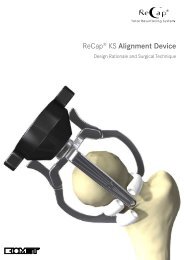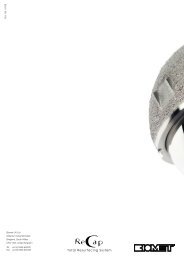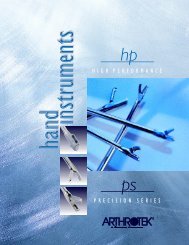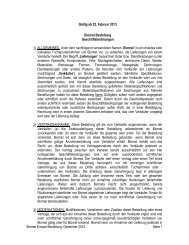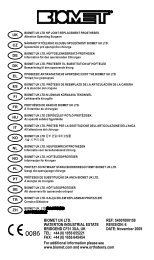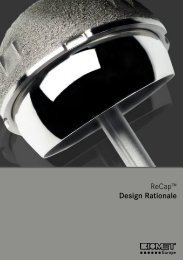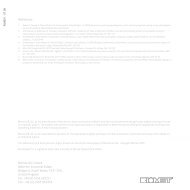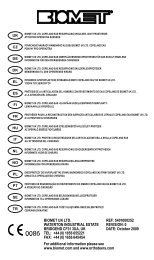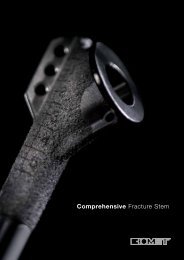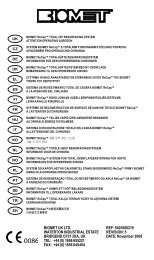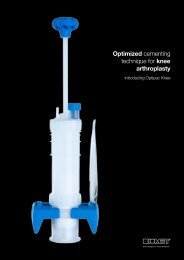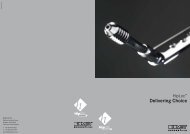The Fusion Alternative - Biomet
The Fusion Alternative - Biomet
The Fusion Alternative - Biomet
You also want an ePaper? Increase the reach of your titles
YUMPU automatically turns print PDFs into web optimized ePapers that Google loves.
<strong>The</strong> <strong>Fusion</strong> <strong>Alternative</strong><strong>The</strong> new <strong>Biomet</strong> ® Maestro WRS is designed to provide a treatment alternative for SLAC (ScapholunateAdvanced Collapse) and other functional deformities, while improving patient range of motion andpain relief. <strong>The</strong> Maestro WRS is available for use as a total wrist replacement (radial and carpal), as wellas a hemi-arthroplasty (carpal replacement only).Revolutionary Design• Metal carpal components allow for hemi-arthroplasty of the carpus• Radial components feature a deep concave body with clinically proven ArCom ® polyethyleneto prevent the potential for dislocation• No need to violate the DRUJ (Distal Radial Ulnar Joint)• MacroBond ® Coating for enhanced fi xationOptimal Patient Sizing• Three carpal head heights allow for additional control of joint distraction• Complete modularity* allows any size of stem, plate and head to be assembled,providing optimal fl exibility in matching the patient’s anatomyVariable Screw Fixation• Variable screw positioning for optimal fi xation• Two low-profi le titanium screws provide fi xation to the carpusScaphoid Augment• Replaces the scaphoid to provide a secure fi t to the capitatePrecise Instruments for Consistent Results• Accurate radial and carpal resection guides• Color-coded instruments allow easy identifi cation of the proper trial*<strong>The</strong> use of the 9.0mm radial stem in combination with the 7.5mm radial body will result in a small amount of overhang.
A New Wrist Option Designed to ProvidePain Relief and Restored Range of MotionMetal Carpal HeadPoly Radial BodyTotal Wrist(radial and carpal replacement)Hemi-Arthroplasty(carpal replacement only)Modular Radial Stems Fit allSizes of Radial Bodies*Modular Radial Bodies withMacroBond ®Coating
the Best of Both Worlds:Capitate StemCurved Carpal Plates available withor without Scaphoid AugmentVariable Screw Positioningfor Optimal FixationAdjustable CarpalHead HeightsArCom ®Direct CompressionMolded Polyethylene
Precise InstrumentationEquals Reproducible Results<strong>The</strong> Maestro WRS represents the nextgeneration of wrist arthroplasty. Commonindications include osteoarthritis and rheumatoidarthritis, but extend into traumatic and revisionsituations where other implants have failed.Using the system’s unique instrumentation andproper surgical technique, the Maestro WRSfacilitates both carpal hemi-arthroplasty and totalwrist reconstruction, to improve range of motionand pain relief.Chisel GuideScrew Depth GuideRadial ChiselResection Guide AssemblyRadial ReamerImplant Assembly ToolCarpal Resection GuideLevel Guide
<strong>Biomet</strong> Orthopedics, Inc. 01-50-0904P.O. Box 587 Date: 06/0556 East Bell DriveWarsaw, Indiana 46581 USAMAESTRO WRIST JOINT REPLACEMENT SYSTEMATTENTION OPERATING SURGEONDESCRIPTION<strong>Biomet</strong> manufactures wrist joint replacement prostheses intended for primary and revisionjoint arthroplasty for use in cemented applications. Wrist joint replacement componentsinclude: multiple piece radial and carpal components, and screws. Components areavailable with a MacroBond® Coat (a thin layer of titanium plasma spray) surface fi nish.Materials:Radial StemsTitanium AlloyRadial BodiesCobalt AlloyCarpal HeadsCobalt AlloyCarpal PlatesCobalt AlloyCapitate StemsTitanium AlloyBearing SurfacesUltra-High Molecular Weight Polyethylene(UHMWPE)Radial ScrewsTitanium AlloyINDICATIONSTotal Wrist Indications<strong>The</strong> Maestro Total Wrist system is indicated for use as a replacement ofwrist joints disabled by pain, deformity and/or limited motion caused by:1. Non-infl ammatory degenerative joint disease including osteoarthritis, traumaticarthritis and avascular necrosis.2. Rheumatoid arthritis.3. Revision where other devices or treatments have failed.4. Scapholunate Advanced Collapse (SLAC) and other functional deformities.5. Trauma, including fractures of the distal radius and/or carpal bones.Carpal Hemiarthroplasty Indications<strong>The</strong> Maestro Carpal Hemiarthroplasty is indicated for use as a replacement of wristjoints disabled by pain, deformity and/or limited motion caused by:1. Non-infl ammatory degenerative joint disease including osteoarthritis, traumaticarthritis and avascular necrosis.2. Rheumatoid arthritis.3. Revision where other devices or treatments have failed.4. Scapholunate Advanced Collapse (SLAC) and other functional deformities.5. Trauma, including fractures of the carpal bones.**Note: <strong>The</strong> Maestro Carpal Hemiarthroplasty is not indicated for fractures of thedistal radius.Patient selection factors to be considered include: 1) need to obtain pain relief andimprove function, 2) ability and willingness of the patient to follow instructions, includingcontrol of activity levels, 3) a good nutritional state of the patient, and 4) the patient musthave reached full skeletal maturity.CONTRAINDICATIONSAbsolute contraindications include: infection, sepsis, and osteomyelitis.Relative contraindications include: 1) uncooperative patient or patients withneurologic disorders who are incapable of following directions, 2) osteoporosis, 3)metabolic disorders which may impair bone formation, 4) osteomalacia, 5) distant fociof infections which may spread to the implant site, 6) rapid joint destruction, markedbone loss or bone resorption apparent on roentgenogram 7) absent or insuffi cient wristextensor tendons.Ordering InformationCarpal PlatesPart No.Size180095 37mm180096 43mm180103 37mm with 6mm augment180104 37mm with 9mm augment180105 37mm with 12mm augment180106 43mm with 8mm augment180107 43mm with 11mm augment180108 43mm with 14mm augmentWARNINGS1. Improper selection, placement, positioning, alignment and fi xation of the implantcomponents may result in unusual stress conditions which may lead to subsequentreduction in the service life of the prosthetic components.2. Malalignment of the components or inaccurate implantation can lead to excessivewear and/or failure of the implant or procedure. Inadequate preclosure cleaning(removal of surgical debris) can lead to excessive wear. Improper preoperative orintraoperative implant handling or damage (scratches, dents, etc.) can lead to crevicecorrosion, fretting, fatigue fracture and/or excessive wear.3. Thoroughly clean and dry connecting segments prior to attachment of componentsto avoid improper seating. Use clean gloves when handling implants. Laboratorytesting indicates that implants subjected to body fl uids, surgical debris or fatty tissuehas lower adhesion strength to cement than implants handled with clean gloves.4. Do not modify implants.5. <strong>The</strong> surgeon is to be thoroughly familiar with the implants and instruments, priorto performing surgery.6. Properly align and securely assemble connecting components. Failure to properlyalign and completely seat the components together can lead to disassociation.Thoroughly clean and dry all connections prior to attachment of modularcomponents to avoid improper seating.7. Care is to be taken to assure complete support of all parts of the device embeddedin bone cement to prevent stress concentrations that may lead to failure of theprocedure. Complete preclosure cleaning and removal of bone cement debris,metallic debris and other surgical debris at the implant site is critical to minimize wearof the implant articular surfaces. Implant fracture due to cement failure has beenreported with joint replacement implants.8. <strong>Biomet</strong>® joint replacement prostheses provide the surgeon with a means of reducingpain and restoring function for many patients. While these devices are generallysuccessful in attaining these goals they cannot be expected to withstand the activitylevels and loads of normal healthy bone and joint tissue.9. Accepted practices in postoperative care are important. Failure of the patientto follow postoperative care instructions involving rehabilitation can compromisethe success of the procedure. <strong>The</strong> patient is to be advised of the limitations ofthe reconstruction and the need for protection of the implants from full loadbearing until adequate fi xation and healing have occurred.10. Excessive activity, trauma and excessive load bearing have been implicated withpremature failure of implants by loosening, fracture, and/or wear. Loosening of theimplants can result in increased production of wear particles, as well as acceleratedamage to bone, making successful revision surgery more diffi cult.11. <strong>The</strong> patient is to be made aware and warned of general surgical risks, possibleadverse effects as listed, and to follow the instructions of the treating physicianincluding follow-up visits.Wrist joint replacement prostheses have not received FDA clearance for non-cementedapplication (USA).PRECAUTIONS1. Specialized instruments are designed for <strong>Biomet</strong>® joint replacement systems to aid inthe proper implantation of the prosthetic components. <strong>The</strong> use of instruments orimplant components from other systems can result in inaccurate fi t, sizing, excessivewear and device failure. Intraoperative fracture or breaking of instruments has beenreported. Surgical instruments are subject to wear with normal usage. Instrumentsthat have experienced extensive use or excessive force are susceptible to fracture.Surgical instruments should only be used for their intended purpose. <strong>Biomet</strong>recommends that all instruments be regularly inspected for wear and disfi gurement.2. Do not reuse implants. While an implant may appear undamaged, previousstress may have created imperfections that would reduce the service life of theScrewsPart No. Size113843 5 x 15mm113844 5 x 20mm113845 5 x 25mm113846 5 x 30mm113847 5 x 35mm113848 5 x 40mm113861 5 x 45mm113862 5 x 50mmimplant. Do not treat patients with implants that have been, even momentarily,placed in a different patient.3. Patient must avoid placing excessive loads on the implant.4. Patient must avoid lifting more than 5 lbs with the operated arm after surgery.5. Patient must avoid putting full body weight on the operated arm when risingfrom a seated position.6. Patient must avoid sudden or strenuous pushing and/or pulling activities aftersurgery, as these can produce excessive stress on the operated arm.7. Patients must avoid full wrist fl exion or extension under load bearing conditions.POSSIBLE ADVERSE EFFECTS1. Material sensitivity reactions. Implantation of foreign material in tissues can result inhistological reactions involving various sizes of macrophages and fi broblasts. <strong>The</strong>clinical signifi cance of this effect is uncertain, as similar changes may occur as aprecursor to or during the healing process. Particulate wear debris and discolorationfrom metallic and polyethylene components of joint implants may be present inadjacent tissue or fl uid. It has been reported that wear debris may initiate a cellularresponse resulting in osteolysis or osteolysis may be a result of loosening of theimplant.2. Early or late postoperative infection, and allergic reaction.3. Intraoperative bone perforation or fracture may occur, particularly in the presence ofpoor bone stock caused by osteoporosis, bone defects from previous surgery, boneresorption, or while inserting the device.4. Nerve injury is a concern in all joint replacement procedures.5. Loosening or migration of the implants can occur due to loss of fi xation, trauma,malalignment, bone resorption, and/or excessive activity.6. Periarticular calcifi cation or ossifi cation, with or without impediment of joint mobility.7. Inadequate range of motion due to improper selection or positioning ofcomponents.8. Undesirable shortening or lengthening of limb.9. Dislocation and subluxation due to inadequate fi xation and improper positioning.Muscle and fi brous tissue laxity can also contribute to these conditions.10. Fatigue fracture of component can occur as a result of loss of fi xation, strenuousactivity, malalignment, trauma, non-union, or excessive load bearing.11. Fretting and crevice corrosion can occur at interfaces between components.12. Wear and/or deformation of articulating surfaces.13. Intraoperative or postoperative bone fracture and/or postoperative pain.STERILITYProsthetic components are sterilized by exposure to a minimum dose of 25 kGy of gammaradiation. Do not resterilize. Do not use any component from an opened or damagedpackage. Do not use implants after expiration date.Caution: Federal law (USA) restricts this device to sale by or on the order of a physician.Comments regarding this device can be directed to Attn: Regulatory Dept., <strong>Biomet</strong>, P.O.Box 587, Warsaw, IN 46581, FAX: 574-372-1683.<strong>The</strong> information contained in this package insert was current on the date this brochurewas printed. However, the package insert may have been revised after that date. Toobtain a current package insert, please contact <strong>Biomet</strong> at the contact informationprovided herein.Carpal HeadsPart No. Size180063 std180064 2mm180065 4mmThis material is intended for the sole use andbenefi t of the <strong>Biomet</strong> sales force and physicians. Itis not to be redistributed, duplicated or disclosedwithout the express written consent of <strong>Biomet</strong>.Maestro and MacroBond ® are trademarks of<strong>Biomet</strong> Manufacturing Corp.Radial BodiesPart No. Size180150 7.5 left180151 7.5 right180152 9.0 left180153 9.0 rightRadial StemsPart No. Size180180 4.5mm dia180181 6.0mm dia180182 7.5mm dia180183 9.0mm diaCaptitate StemsPart No. Size180120 12mm long180121 15mm long180122 18mm longDrivenByEngineeringP.O. Box 587, Warsaw, IN 46581-0587 • 800.348.9500 ext. 1501©2005 <strong>Biomet</strong> Orthopedics, Inc. All Rights Reserved • www.biomet.comForm No. Y-BMT-949/113005/K


